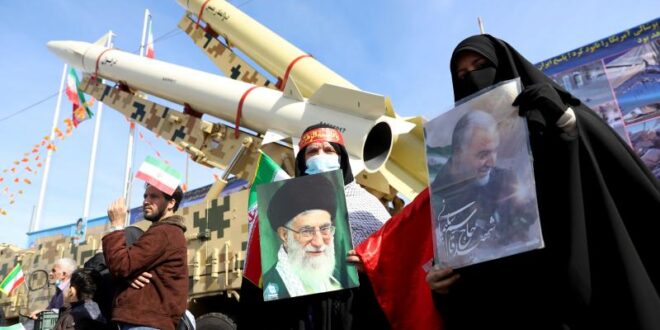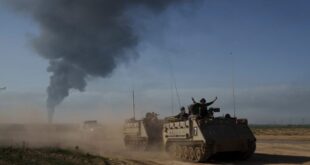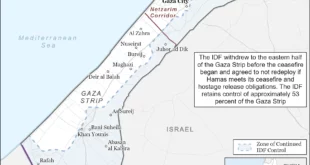Iran is closer than ever to being able to build a nuclear weapon. After President Donald Trump pulled out of the 2015 nuclear deal, Tehran began enriching uranium to higher levels and stockpiling more of it. As a result, Iran now has the capacity to make enough fissile material for a nuclear bomb in less than a month—compared with the roughly one year it would have needed to do so before the United States quit the nuclear accord in 2018.
Iran’s leaders and President Joe Biden’s administration both say they want to return to the 2015 deal, but the parties remain far apart on what nuclear steps or sanctions relief should come first and how far-reaching those steps would need to be. Every day that the talks drag on without resolution, Iran’s centrifuges keep spinning; in late December, European governments warned that “weeks, not months,” remained before restoring the old deal would no longer be possible.
The hard truth is that the United States now has few good options for containing Iran’s nuclear program. It can persist with the no-deal status quo, allowing Iran to continue inching closer to a bomb while suffering under sanctions. It can pursue a return to the 2015 agreement and then attempt to get Iran to agree to a “longer and stronger” pact, as the Biden team has suggested. It can try for various other deals, either more or less stringent than the 2015 agreement. Or it can attempt to destroy Iran’s nuclear infrastructure with a military strike, possibly setting Tehran’s progress toward a bomb back by a few years but almost certainly provoking retaliation and possibly a sprint toward the nuclear finish line.
Of these options, a return to the 2015 deal is the least bad. It would pull Iran back from the nuclear brink, and it would offer modest hope for further talks on hard problems such as Iran’s missile program and its support for armed groups throughout the Middle East. It would pose far fewer risks than attempting to set Iran’s program back with a military strike, and it would likely buy more time. But Iran’s gains in knowledge are irreversible, meaning that the old accord won’t be as strong a barrier to the bomb as it was before Trump tore it up, and getting Tehran to agree to strengthen the deal over time will be difficult.
NUCLEAR AMBITIONS
Iran claims that its decades-long nuclear program has always been entirely peaceful. But a wide range of sources of information—confirmed and expanded by an archive of Iranian documents Israeli agents stole in 2017—proves that at least from 1999 to 2003, Iran sought to design and manufacture nuclear weapons and to carry out a nuclear test. It was a comprehensive effort that included each element needed to produce nuclear materials and fabricate them into bombs. The secret program was led by Mohsen Fakhrizadeh, a nuclear scientist and Islamic Revolutionary Guard Corps officer who was assassinated, reportedly by Israeli intelligence, in November 2020.
In late 2003, after the United States invaded Iraq and international inspectors began probing some once secret Iranian activities, Iran shut down the parts of its program that were most identifiable as nuclear weapons efforts or that were still covert. But it continued its open uranium enrichment program—suitable for making low-enriched fuel for reactors as well as highly enriched material for bombs—and the construction of a “research reactor” at Arak that was well suited for producing weapons-grade plutonium.
By 2015, Iran had mastered centrifuge uranium enrichment, installed thousands of first-generation centrifuges, started to test more advanced centrifuges that could enrich uranium even faster, and stockpiled substantial amounts of low-enriched uranium. Uranium enrichment is an exponential process, so once centrifuges have increased the 0.7 percent U-235 that comes out of the ground to the four percent suitable for reactor fuel, they have already done two-thirds of the work to reach the 90 percent enriched material typically used for nuclear weapons. In other words, Iran’s large stock of low-enriched uranium meant that it was two-thirds of the way to producing the highly enriched uranium for its first bomb—a process that U.S. officials publicly estimated Iran could have completed in three months.
Today, Iran is closer to a bomb than ever.
The 2015 nuclear deal changed all that. In return for sanctions relief, Iran agreed never to design or build nuclear weapons, took down and stored more than two-thirds of its centrifuges, disposed of 98 percent of its enriched uranium, poured cement into the core of the Arak reactor, agreed never to conduct a range of activities relevant to nuclear bomb development, and accepted a far-reaching set of verification measures.
These limits were designed to lengthen Iran’s timeline for producing bomb material to roughly a year—enough time for the international community to detect such an effort and take action to stop it. But the nuclear deal was a compromise, and its enrichment restraints contained “sunset clauses” that expired in ten to 15 years; its inspection provisions, while unprecedented, were far from “anytime, anywhere”; and it did not require Iran to confess all of its past nuclear activities. Moreover, lifting sanctions and unfreezing assets gave Iran more money, some of which went to support armed groups throughout the Middle East or to further its missile program, neither of which was covered by the deal. The pact’s advocates saw it as “a floor, not a ceiling,” hoping that the benefits of cooperation and increased economic integration with the West would make additional deals and ultimately a different relationship with Iran possible.
None of that happened, of course. Trump withdrew the United States from the accord in 2018, imposing stringent sanctions on Iran with which companies around the world were forced to comply if they didn’t want to be frozen out of the U.S. market and financial system. Iran’s currency plunged, inflation and unemployment soared, and poverty mounted. Remarkably, Iran continued to comply with the terms of the deal for a year after the United States withdrew, making sure the blame would be firmly fixed on Washington. But then it began to step past the deal’s restraints, gradually exceeding the limits on enrichment until in January 2020 it finally announced that its enrichment program would no longer be constrained by the deal at all.
THE NUCLEAR PRECIPICE
Today, Iran is closer to a bomb than ever. The latest reports from the International Atomic Energy Agency, published in November 2021, show that Iran has surged far past the limits of the 2015 accord. Tehran’s experts are casting uranium metal, gaining valuable experience they would need to make uranium weapon components. Iran has also blown past the 3.67 percent enrichment limit set by the 2015 deal and is now enriching uranium at up to 60 percent—an easy jumping-off point to produce 90 percent enriched uranium for weapons (or material Iran could use directly in weapons if it modified its nuclear weapon and missile designs). Meanwhile, Iran’s stocks of enriched uranium have grown to over seven times the 2015 limit, and the country has enough 20 percent and 60 percent enriched uranium to rapidly make a bomb’s worth of weapons-grade highly enriched uranium. And despite a dramatic explosion in April at its largest enrichment facility, allegedly a result of an Israeli operation, Iran is running more centrifuges than the 2015 deal permitted, including hundreds of advanced centrifuges, and testing still more advanced devices.
The combination of enriched uranium stocks and advanced centrifuges enables Iran to produce the material for its first bomb in roughly a month—a time frame that will continue to shrink as Tehran’s stocks of 60 percent enriched uranium grow. In another couple of months after a breakout, Iran could have enough material for a second bomb, and then a third and a fourth soon after that. At the same time, Iran has scrapped the extra monitoring agreed to in the 2015 deal and continued to provide false information about the origin of human-made uranium particles inspectors found at several undeclared sites (although it has continued to allow inspections of its declared nuclear facilities).
A return to the 2015 deal could roll back some of Iran’s nuclear progress.
A return to the 2015 deal could roll back some of Iran’s nuclear progress, getting rid of the extra enriched uranium stocks, dialing enrichment back down to 3.67 percent, and taking the advanced centrifuges offline. But the knowledge Iran has gained can’t be erased. Day by day, Iran is gaining more insight into casting uranium metal, operating and manufacturing higher-performance centrifuges, handling highly enriched uranium without causing accidental chain reactions, and frustrating international inspectors without provoking a serious response.
Yet producing enough highly enriched uranium for a nuclear weapon is not the same as making a nuclear weapon. To make a weapon, Iran would have to cast and machine the uranium components, manufacture shaped explosives to crush a ball of uranium to much higher density, make exquisitely timed detonators to set off those explosives on all sides of the bomb at the same time, and build a device to set off a shower of neutrons at the right moment to start the chain reaction. Iran worked on all of that in its old nuclear weapons program. But it is unclear how much Iran’s bomb-making capabilities have atrophied in the 18 years since the main parts of its weaponization effort ended or how much the assassination of Fakhrizadeh and other nuclear scientists—as well as the natural deaths and retirements of others—has set the country back. Israeli intelligence agents are optimistic, estimating that even once it has produced enough highly enriched uranium, Iran would need between a year and a half and two years to make a bomb. That’s probably in the right ballpark, unless Iran has unknown secret facilities. But once Iran has produced enough highly enriched uranium, it could hide the material away, making it very difficult to find and disrupt any program to manufacture a bomb.
TOUGH CHOICES
Iran’s rapid progress on the nuclear front has left the United States with few good options. Without a deal, Tehran’s nuclear program will be essentially unfettered: only fear of provoking a military strike will limit Iran’s progress toward a bomb. The Nuclear Nonproliferation Treaty—to which Iran is a party—still prohibits Tehran from making nuclear weapons, but the treaty does not bar the production or storage of weapons-usable nuclear material, so long as it is under international inspection. As a result, Iran might choose to build up its stocks of 60 percent enriched uranium so that it has enough, if further enriched, for several nuclear bombs. Iran would likely also continue testing and manufacturing advanced centrifuges so that it is ready to move rapidly—possibly at a secret site—if it ever decides to take the final step toward nuclear weapons. The only real tools the United States would have to constrain Iran in this case are sabotage and sanctions. Sanctions might modestly limit Iran’s financial support to armed groups in the Middle East, but they would also cause substantial suffering for Iran’s people. Sabotage can create setbacks for Iran, but only temporary ones. Neither, so far, has stopped Iran from making substantial progress toward a bomb. And such actions come with their own risks, potentially heightening the sense of threat that strengthens the position of Tehran’s bomb advocates and intensifying the low-level “shadow war” between Iran, the United States, Israel, and the Gulf states.
Should the United States manage to revive the 2015 deal, it would reduce the nuclear threat posed by Iran, but not to the extent that the original agreement did. More than six years of the time bought by the deal is gone, along with most hopes that the pact could establish habits of cooperation on which additional agreements could be built. And even if Iran mothballed its extra centrifuges and gave up its extra stocks of enriched uranium, it would probably be able to have those same centrifuges up and running again at known or secret sites in relatively short order should it choose to violate the pact. It could also make more centrifuges, expanding its enrichment capacity much faster than it would have been able to before the United States withdrew from the 2015 deal. (One key uncertainty is how rapidly Iran would be able to make and install more of these advanced centrifuges.) By one estimate, reviving the deal would lengthen Iran’s timeline for producing a bomb’s worth of material to between five and six months—up from less than a month today but well down from roughly a year when the deal was first fully implemented in 2016. And returning to the deal would involve again lifting key sanctions on Iran, strengthening the Iranian government and reducing Western leverage.
Some experts have suggested settling for a “less for less” approach—for example, getting Iran to relinquish its stocks of 60 percent enriched uranium, stop stockpiling more enriched uranium, and halt the installation of new centrifuges in return for lifting some sanctions. Such an arrangement might buy some time for talks, but it is by no means a long-term solution.
Others have urged the Biden administration to give up on reviving the 2015 deal and instead impose tougher sanctions to convince Iran to compromise, offering a “more for more” arrangement in which Tehran would accept more substantial restraints than the 2015 deal—perhaps combined with some limits on its missiles and regional activities—in return for lifting even more sanctions (and perhaps other benefits). But the current mess is the result of Trump’s “maximum pressure” campaign, so there is little reason to think that more of the same will lead to a breakthrough. In Tehran, Trump’s exit from the deal has vindicated those who argue that Washington will never be a reliable partner, and these hard-liners now hold the levers of power. Moreover, Iranian President Ebrahim Raisi’s most recent budget proposal assumes that Iran’s economy will grow at eight percent in the coming budget year even without a deal, suggesting that he doesn’t feel much urgency to compromise. And historically, Iran has responded to Western efforts to build leverage by trying to build counterleverage of its own—which partly explains why Iran has deployed so many centrifuges, stockpiled so much enriched uranium, and supported so many armed groups throughout the Middle East.
A military strike could buy from two to five years— less than a negotiated deal could provide.
A more plausible path to a longer and stronger deal would be to first return to the original deal and then attempt to lengthen and strengthen it in subsequent negotiations. That’s worth trying. But because a return to the 2015 deal would require lifting many of the sanctions on Tehran, Washington’s leverage for better terms down the road would be reduced.
A final option is a military strike, which could temporarily disable much of Iran’s nuclear infrastructure. Although Iran could use its deep underground Fordow Fuel Enrichment Plant to produce bomb material, some types of bunker-busting bombs would be able to damage the plant, and the tunnels into the site could be destroyed. But other nuclear facilities would also need to be destroyed, along with Iran’s extensive air defenses, making such an attack a large and complex air operation—far more difficult than the single-site strikes that Israel conducted against Iraq’s Osiraq reactor in 1981 and Syria’s Al Kibar reactor in 2007.
The U.S. military is capable of carrying out such an assault, and Israel has been improving its ability to do so (although its long-range refueling and bunker-busting abilities are more limited). But afterward, Iran would likely rebuild at secret locations, and it might well decide to kick out inspectors and try to build a nuclear weapon before it was found out and attacked again. In other words, such a strike might increase, rather than decrease, the long-term probability that Iran would obtain a nuclear bomb.
Estimates for how much time a military strike could buy range from two to five years— less than a negotiated deal could provide. If in the wake of a strike foreign intelligence agencies located new secret sites, another round of strikes would be needed and possibly another after that. Iran and its proxies would almost certainly retaliate, and they have many options—from long-range missiles that can reach Israel to an estimated 100,000 missiles and rockets in Hezbollah’s hands to ultraprecise drones that carried out what amounted to a warning strike at Saudi Arabia’s largest oil facility in 2019. Neither Iran nor the United States wants another full-scale war in the Middle East, but the risk of blundering into one would be substantial. And, of course, military attacks on foreign countries that are not carried out in self-defense are banned by international law. On the whole, then, the option of a military strike is the riskiest of all, though it would have to be considered if Iran ever did begin racing for the bomb.
SWALLOW HARD AND DEAL
In short, Iran’s nuclear progress has left the United States with some ugly options. Restoring the 2015 deal won’t buy as much time or safety as the original deal did, but doing so is the best of a bad set of choices. Not only would a return to the deal technically constrain Iran’s program, but by reducing the threats to Iran and creating a flow of benefits from cooperation with the West, it would weaken Tehran’s bomb advocates and strengthen those arguing that Iran should maintain the option to build a bomb without incurring the costs and dangers of actually building one. Ultimately, Iran has the technical capability to make a nuclear weapon; Washington’s goal must be to convince Iran’s leaders to choose not to do so.
The Biden administration is therefore right to try to find a path back to compliance with the original deal and from there to a longer and stronger follow-on accord. But with Iran’s hard-line leadership justifiably doubting American promises, there is no guarantee it will be possible to get back to the 2015 pact. And as time passes, the benefits of a return to the original deal will continue to diminish. Moreover, it will not be easy to limit the dangers of Iran’s nuclear program after the sunset clauses expire or to constrain its advancing missile program or address its support for armed groups throughout the Middle East. Ultimately, what is needed is a different relationship between Iran, its neighbors in the Middle East, and the West. A return to the nuclear deal would be one step forward on that long and difficult road.
 Eurasia Press & News
Eurasia Press & News



